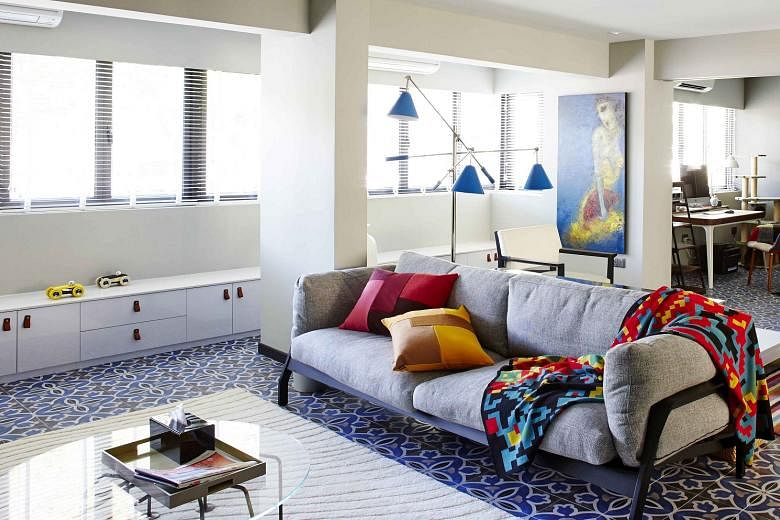Pet-proof your sofa
Are leather or fabric-upholstered sofas better for homes with pets? It depends on whether you have dogs or cats and their breed. Most pet owners will make the wrong choice with at least one sofa or armchair and learn what not to buy the next time. The key is not to just choose wisely, but also practise some furniture-saving habits.
Leather, particularly distressed leather, may be hardy, but scratches can show up on it easily. However, pet hair does not get trapped as there is no fibre to catch onto and it will require only a weekly vacuum.
If you prefer fabric, choose outdoor fabric as it repels water (or drool), is stain- and fade-resistant as well as easy to clean.
Other dog-friendly choices include microfibre, a thin and durable material with a very tight weave, and ultrasuede. These feel soft and luxurious. Both tend to be directional, which means you will leave a mark on the surface when it is touched.
Cat owners should consider their pets' thin sharp claws that snag fabric. Forget any loose weave fabric and choose velvet, leather or ultrasuede. Compared with fabric, velvet has a cut-pile, instead of a looped pile, which gives cat claws nothing much to catch onto.
Cats will also find it hard to scratch leather and ultrasuede.
Keep your pet groomed (to minimise shedding dander on the sofa and cushions) and occupied (to prevent animals such as cats from clawing at the furniture).
Giving your dog a bath and brushing its fur help to keep it off your sofa.
Pet hair on fabric or leather is not only unsightly, but it can also stain your sofa as it contains an oil which can attract dirt.
Place a machine-washable blanket or throw over the spot your pet likes to rest on to extend the life of your sofa.
Go online for D-I-Y toilet solutions
The water in my WC keeps overfilling and I have to constantly turn off the valve at the supply line. What causes this and is there a D-I-Y solution? There are a few things that can go wrong inside the tank of a toilet that would cause it to fill more often than it should. Some refer to this as a "running toilet".
The problem most likely lies with the flapper, fill valve, flush valve or flush lever assembly. It is hard to pinpoint the cause without looking at your toilet, but there are plenty of online resources for D-I-Y handymen.
Go to Home & Decor's website at www.homeanddecor.com.sg for more tips on choosing and maintaining your WC.
Retile bathroom wall to prevent further cracking

I live in an apartment and the tiles on my bathroom wall recently keep cracking and falling off. This has happened repeatedly even after I have replaced the tiles and checked that there are no leaks in the pipes. What is causing this? According to established interior design studio Collective Designs, tile cracking can be due to vibration or ground movements, inferior tile quality, erratic weather conditions that cause walls to contract and expand or the strength of cement or bonding material used to adhere the tiles to the walls.
The only remedy is to remove the tiles and retile the area correctly.
Mould on walls due to changing temperature

There seems to be black mould on my bedroom walls. I switch on the air-conditioning only at night, but is that the cause of the dampness on the walls? Ms Doreen Low of water-leak specialist company Global Technical is familiar with such situations as yours.
"In our experience, the condition usually exists in areas where the house is in high-humidity wooded areas and shaded from direct sunlight," she says.
"When the air-conditioning is switched on, the whole room - including the walls - cools down. In the morning, when you open the windows to air the room, humid air enters and makes contact with the cold walls. The water vapour in the air condenses into minute droplets of water, thus making the wall damp and enabling the mould to grow."
So start a routine of turning on a fan at high speed when you switch off the air-conditioning and before you open the windows. This ventilation will minimise condensation and bring the temperature in the room slowly up to the ambient temperature.
"Alternatively, you can wait till the room warms up to the ambient temperature before opening the windows."

• Home & Decor and experts in renovation and home decoration answer queries from readers in this series. These questions first appeared in the June issue of Home & Decor, published by SPH Magazines.
• Got a decorating or home renovation issue? Write to Experts Say, Home & Decor, Level 7 Media Centre, 82 Genting Lane, Singapore 349567 or e-mail maghomedecor@sph.com.sg. Photos and layouts are non-returnable.

